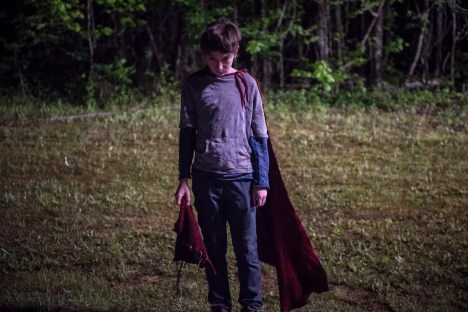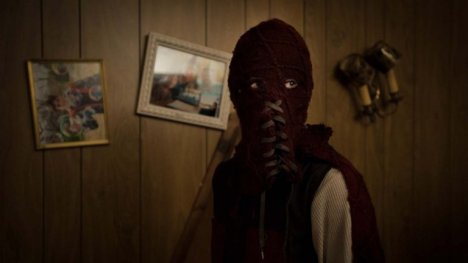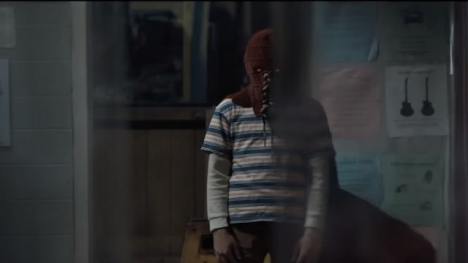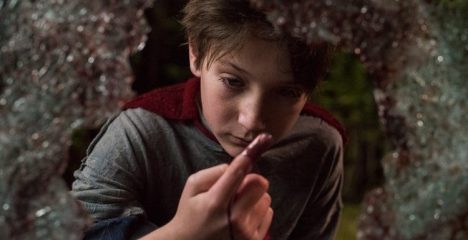Brightburn is effectively an elevator pitch movie. It’s a heady cocktail combining Man of Steel, The Omen and We Need to Talk About Kevin into a single ninety-minute movie.
Brightburn often feels more like a sketch extended to feature length rather than a movie of itself. Its characterisation is light, its worldbuilding is shallow, its premise is not so much developed as directly stated. With the notable exception of Elizabeth Banks, who largely anchors the film in emotional terms, the performances are largely blank and generic. This is especially true of Jackson A. Dunn, who is cast in the title role. There is something very threadbare about Brightburn, as if the film is operating on nothing more than its fairly simple premise.

Red eyes at night…
Oddly enough, this all serves to make Brightburn more effective than it might otherwise be. Brightburn is a single-minded film, arguably powered entirely by its own high concept. That high concept is ingenious, and enough to sustain the film across the entirety of its ninety-minute runtime. Brightburn feels relatively light, but that is almost by design. There is little ambiguity about what it is doing, and why it is doing it. There is no clutter, no distraction, no wondering attention. Brightburn is little more than its central narrative engine, but that engine is a powerful and compelling force.
Brightburn is not a subtle film. It has all the nuance of its title character, smashing through wood as though it were wet cardboard. Somehow, that lack of subtlety makes it all the more effective.

Holy Moses.
The most immediate point of reference for Brightburn is Zack Snyder’s Man of Steel, the 2013 cinematic reimagining of Superman for the twenty-first century. As with everything that Brightburn does, this frame of reference is not buried especially deep. Brightburn riffs repeatedly on the Malick-inspired visuals of Man of Steel; there are lots of shots of pastoral countryside in greens and yellows and browns, often set against a clear (and endless) blue sky. The establishing shots feature a swing swaying gently in the breeze, and a child’s abandoned bike in the grass.
Brightburn was shot in Georgia, using the state to double for Kansas. This isn’t entirely convincing, given the differences in topography between the two regions. Nevertheless, Brightburn is consciously aiming for – and largely captures – an idyllic snapshot of rural Americana. Director David Yarovesky borrows several of Snyder’s visual cues as shorthand, especially those low angle shots with lens flair. Composer Timothy Williams riffs rather blatantly on Hans Zimmer’s What Are You Going to Do When You Aren’t Saving the World? at several points in the film.

Cape of no hope.
To a certain extent, Brightburn is very obvious pitch; the question of what would happen if just one of the underlying variables of the iconic Superman origin story were shifted ever so slightly. After all, Snyder already did a variant of it in Man of Steel. Although far too unfocused and cluttered for its own good, Man of Steel was a story of biblical awe. It was about confronting mankind with an idea as powerful as Superman, a transcendental idea that reframed humanity’s self-image.
More than that, one of the more underrated aspects of Man of Steel was the way in which it deconstructed the idea of the Kent family as an ideal, asking what would happen if Kal El ended up in a state that voted for Donald Trump over Hillary Clinton or Mitt Romney over Barack Obama. More optimistic than many gave it credit for, Man of Steel argued that it would take an exceptional person to transcend that sort of worldview, the narrow self-interest of a community terrified of anything beyond its understanding. Clark Kent became a hero in spite of his adopted parents, not because of them.

All good in the hood.
Brightburn essentially inverts the dynamic. Owing a lot to films like The Omen or We Need to Talk About Kevin, Brightburn is a story about parents who find themselves literally alienated from their child. Over the course of the film’s hour-and-a-half runtime, Tori and Kyle Breyer are forced to acknowledge that their beloved son is transforming into – or maybe always has been – something that exists outside their frame of reference. They cannot understand him. They cannot connect with him. They cannot stop him. Strip out the cape and the mask, and Brightburn is a familiar story of parental anxiety.
Again, this is reductive. Nevertheless. Brightburn is heavily influenced by classic childhood-related horrors like The Exorcist or Children of the Corn, those stories tapping into the fears of parents unsure what their children are becoming. At one point, Brandon’s mother finds her son floating in midair having a seizure and speaking in tongues. Although echoing a standard superhero beat, it more overtly evokes a demonic possession. Even more primal that that, it is an expression of the fear that our children might be monsters, even if the particulars of that monstrous form change with time.

Floating some ideas.
Brightburn very cannily and very cleverly reframes a lot of the visual trappings of the Superman mythos as horror movie clichés. Again, it’s a very simple and straightforward premise. It is a high-concept for a sketch. In Brightburn, the aspects of the Superman mythos that are supposed to be comforting become horrifying; the character’s ability to enter and leave a scene in the blink of an eye, the feet suspended above the ground and gliding with steady inevitability, the car lifted over the character’s head, the image of a god overhead looking down on the mortals below.
Notably, Brightburn repurposes a lot of the signifiers of the superhero in the language of the serial killer film. As Brandon develops, he begins sketching a superhero persona for himself. The logo is like that of a standard superhero – it is symmetrical, built around familiar geometric shapes. However, it is employed like a grim calling card, left tauntingly at horrific crime scenes. Brandon knits himself a mask that his uncle derides as “creepy”, only for the teenager to awkwardly insist, “It’s not creepy.”

A god outside watching.
Brandon is a superhero because superheroes reflect contemporary pop culture. This seems to get at the biggest idea in Brightburn, one not about Brandon so much as about culture. Notably, at one point he sneaks into the room of a girl that he likes to express his affection in the style of countless eighties teen romcoms and Twilight. More than that, Brandon seems to passively absorb his attitudes and his beliefs from the atmosphere around him. Brightburn is a tale of male entitlement. The first word that he learns in his native tongue is “Take.” His father tells him early on, “It’s okay to give into your urges.”
Stripped of its genre signifiers, Brandon’s arc is depressingly familiar to anybody who has watched the news in recent years. Brightburn makes a point to emphasise Brandon’s social isolation; the only people at his twelfth birthday party are adult relatives. The nature of Brandon’s transformation from lonely-but-lovable kid into source of terror is repeatedly framed in terms of power dynamics. More to the point, Brandon’s early expressions of power – and his altered antisocial mood – are denoted by the flickering of screens as if to suggest a connection to Brandon’s development into an alien monstrosity.

Shattering expectations.
Brandon’s violence is firmly gendered by Brightburn, perhaps the most interesting – and unsettling – aspect of the film’s approach to the character. “You’re twelve years old,” his father tells the young boy. “Pretty soon you’re going to be a man. You’re going to start to have feelings about women… about women’s bodies.” Naturally, they are on a hunting trip when Kyle decides to reinforce this message to Brandon. Brandon had just received a rifle as a gift from his uncle Royce. What message is Brandon supposed to take, even before the piece of alien technology in the barn starts telling him to “take” what is his?
Brightburn is explicit in Brandon’s preoccupations. It is very telling that the primary targets of his obsession are all women; his crush, the school counselor who his also his aunt, his mother. The men that Brandon kills are largely incidental to this obsession. They get in the way, or they present an immediate threat to him. Even at the climax of the film, as the situation dramatically escalates, Brandon devoted considerably more time to the female deputy than the male sheriff.

Alien nation.
Brandon is interested in women, but most specifically in their bodies. As with a lot of the film, Brightburn is less than subtle in how it approaches this point. In an early investigation of his room, Tori and Kyle uncover “what passes for porn” to the young man – images of models in bikinis and swimsuits. However, as they dig deeper into the pile, they find these pictures mixed in with unsettlingly detailed anatomical drawings. As with David in Alien: Covenant, Brandon’s preoccupation with controlling women’s bodies is an essential part of his pathology; the film returns to that obsession at the climax.
Brightburn is an extremely light premise. It is arguably more of a broadly-drawn sketch than a fully-formed movie in its own right. However, the tight ninety minute run-time helps to keep things ticking along at a decent clip, and its basic ideas are enough to sustain the film for ninety minutes. There is something very effective and compelling about watching a teenage boy’s self-involved power fantasy curdle into outright horror. It feels like a sadly necessary – and inevitable – story at this moment in time.
Filed under: Non-Review Reviews | Tagged: brightburn, film, man of steel, Movie, non-review review, review, superhero, superman |




















Leave a comment